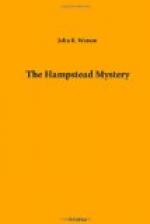“I want you to keep in mind, when arriving at your verdict, that there are certain material facts which have been admitted by the defence,” said Mr. Walters in concluding his address to the jury. “It has been admitted that the prisoner was a party to a proposal to break into Riversbrook. As far as that goes, there is no suggestion that he walked into a trap. Whether he arranged the burglary and compelled Hill to help him, or whether Hill arranged it and sought out the prisoner’s assistance is, after all, not very material. What is admitted is that the prisoner went to Riversbrook with the intention of committing a crime. It is admitted that he knew Sir Horace Fewbanks had returned home. In that case is it not reasonable to suppose that the prisoner would arm himself, I do not say with the definite intention of committing murder, but for the purpose of threatening Sir Horace if necessary in order to make good his escape? What is more likely than that Sir Horace heard the burglar in the house, crept upon him, and then tried to capture him? There was a struggle, and the prisoner, determined to free himself, drew his revolver and shot Sir Horace. Is not such a theory of the crime—that Sir Horace was shot while trying to capture the prisoner—more probable than the theory of the defence that Hill, the weak-willed, frightened-looking man you saw in the witness-box, was a masterful, cunning criminal who for some inexplicable reason had turned ferociously on the master who had befriended him and given him a fresh start in life, had killed him and left the body in the house, and had then managed to direct




